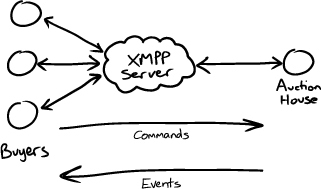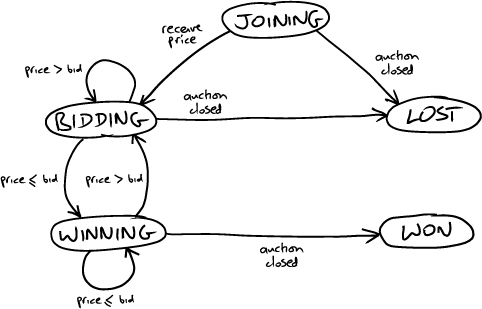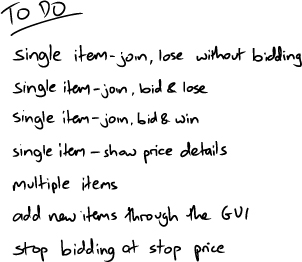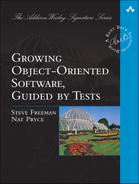Chapter 9. Commissioning an Auction Sniper
To Begin at the Beginning
In which we are commissioned to build an application that automatically bids in auctions. We sketch out how it should work and what the major components should be. We put together a rough plan for the incremental steps in which we will grow the application.
We’re a development team for Markup and Gouge, a company that buys antiques on the professional market to sell to clients “with the best possible taste.” Markup and Gouge has been following the industry and now does a lot of its buying online, largely from Southabee’s, a venerable auction house that is keen to grow online. The trouble is that our buyers are spending a lot of their time manually checking the state of an auction to decide whether or not to bid, and even missed a couple of attractive items because they could not respond quickly enough.
After intense discussion, the management decides to commission an Auction Sniper, an application that watches online auctions and automatically bids slightly higher whenever the price changes, until it reaches a stop-price or the auction closes. The buyers are keen to have this new application and some of them agree to help us clarify what to build.
We start by talking through their ideas with the buyers’ group and find that, to avoid confusion, we need to agree on some basic terms:
• Item is something that can be identified and bought.
• Bidder is a person or organization that is interested in buying an item.
• Bid is a statement that a bidder will pay a given price for an item.
• Current price is the current highest bid for the item.
• Stop price is the most a bidder is prepared to pay for an item.
• Auction is a process for managing bids for an item.
• Auction house is an institution that hosts auctions.
The discussions generate a long list of requirements, such as being able to bid for related groups of items. There’s no way anyone could deliver everything within a useful time, so we talk through the options and the buyers reluctantly agree that they’d rather get a basic application working first. Once that’s in place, we can make it more powerful.
It turns out that in the online system there’s an auction for every item, so we decide to use an item’s identifier to refer to its auction. In practice, it also turns out that the Sniper application doesn’t have to concern itself with managing any items we’ve bought, since other systems will handle payment and delivery.
We decide to build the Auction Sniper as a Java Swing application. It will run on a desktop and allow the user to bid for multiple items at a time. It will show the identifier, stop price, and the current auction price and status for each item it’s sniping. Buyers will be able to add new items for sniping through the user interface, and the display values will change in response to events arriving from the auction house. The buyers are still working with our usability people, but we’ve agreed a rough version that looks like Figure 9.1.
Figure 9.1 A first user interface

This is obviously incomplete and not pretty, but it’s close enough to get us started.
While these discussions are taking place, we also talk to the technicians at Southabee’s who support their online services. They send us a document that describes their protocol for bidding in auctions, which uses XMPP (Jabber) for its underlying communication layer. Figure 9.2 shows how it handles multiple bidders sending bids over XMPP to the auction house, our Sniper being one of them. As the auction progresses, Southabee’s will send events to all the connected bidders to tell them when anyone’s bid has raised the current price and when the auction closes.
Figure 9.2 Southabee’s online auction system

Communicating with an Auction
The Auction Protocol
The protocol for messages between a bidder and an auction house is simple. Bidders send commands, which can be:
Join
A bidder joins an auction. The sender of the XMPP message identifies the bidder, and the name of the chat session identifies the item.
Bid
A bidder sends a bidding price to the auction.
Auctions send events, which can be:
Price
An auction reports the currently accepted price. This event also includes the minimum increment that the next bid must be raised by, and the name of bidder who bid this price. The auction will send this event to a bidder when it joins and to all bidders whenever a new bid has been accepted.
Close
An auction announces that it has closed. The winner of the last price event has won the auction.
We spend some time working through the documentation and talking to Southabee’s On-Line support people, and figure out a state machine that shows the transitions a Sniper can make. Essentially, a Sniper joins an auction, then there are some rounds of bidding, until the auction closes, at which point the Sniper will have won or lost; see Figure 9.3. We’ve left out the stop price for now to keep things simple; it’ll turn up in Chapter 18.
Figure 9.3 A bidder’s behavior represented as a state machine

The XMPP Messages
Southabee’s On-Line has also sent us details of the formats they use within the XMPP messages. They’re pretty simple, since they only involve a few names and values, and are serialized in a single line with key/value pairs. Each line starts with a version number for the protocol itself. The messages look like this:

Southabee’s On-Line uses login names to identify items for sale, so to bid for an item with identifier 12793, a client would start a chat with the “user” auction-12793 at the Southabee’s server. The server can tell who is bidding from the identity of the caller, assuming the accounts have been set up beforehand.
Getting There Safely
Even a small application like this is too large to write in one go, so we need to figure out, roughly, the steps we might take to get there. A critical technique with incremental development is learning how to slice up the functionality so that it can be built a little at a time. Each slice should be significant and concrete enough that the team can tell when it’s done, and small enough to be focused on one concept and achievable quickly. Dividing our work into small, coherent chunks also helps us manage the development risk. We get regular, concrete feedback on the progress we’re making, so we can adjust our plan as the team discovers more about the domain and the technologies.
Our immediate task is to figure out a series of incremental development steps for the Sniper application. The first is absolutely the smallest feature we can build, the “walking skeleton” we described in “First, Test a Walking Skeleton” (page 32). Here, the skeleton will cut a minimum path through Swing, XMPP, and our application; it’s just enough to show that we can plug these components together. Each subsequent step adds a single element of complexity to the existing application, building on the work that’s done before. After some discussion, we come up with this sequence of features to build:
Single item: join, lose without bidding
This is our starting case where we put together the core infrastructure; it is the subject of Chapter 10.
Single item: join, bid, and lose
Add bidding to the basic connectivity.
Single item: join, bid, and win
Distinguish who sent the winning bid.
Show price details
Start to fill out the user interface.
Multiple items
Support bidding for multiple items in the same application.
Add items through the user interface
Implement input via the user interface.
Stop bidding at the stop price
More intelligence in the Sniper algorithm.
Within the list, the buyers have prioritized the user interface over the stop price, partly because they want to make sure they’ll feel comfortable with the application and partly because there won’t be an easy way to add multiple items, each with its own stop price, without a user interface.
Once this is stable, we can work on more complicated scenarios, such as retrying if a bid failed or using different strategies for bidding. For now, implementing just these features should keep us busy.
We don’t know if this is exactly the order of steps we’ll take, but we believe we need all of this, and we can adjust as we go along. To keep ourselves focused, we’ve written the plan on an index card, as in Figure 9.4.

This Isn’t Real
By now you may be raising objections about all the practicalities we’ve skipped over. We saw them too. We’ve taken shortcuts with the process and design to give you a feel of how a real project works while remaining within the limits of a book. In particular:
• This isn’t a realistic architecture: XMPP is neither reliable nor secure, and so is unsuitable for transactions. Ensuring any of those qualities is outside our scope. That said, the fundamental techniques that we describe still apply whatever the underlying architecture may be. (In our defense, we see that major systems have been built on a protocol as inappropriate as HTTP, so perhaps we’re not as unrealistic as we fear.)
• This isn’t Agile Planning: We rushed through the planning of the project to produce a single to-do list. In a real project, we’d likely have a view of the whole deliverable (a release plan) before jumping in. There are good descriptions of how to do agile planning in other books, such as [Shore07] and [Cohn05].
• This isn’t realistic usability design: Good user experience design investigates what the end user is really trying to achieve and uses that to create a consistent experience. The User Experience community has been engaging with the Agile Development community for some time on how to do this iteratively. This project is simple enough that we can draft a vision of what we want to achieve and work towards it.
